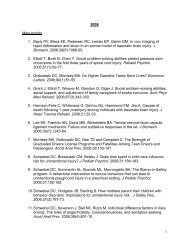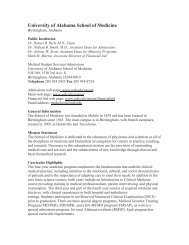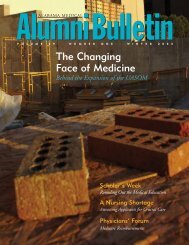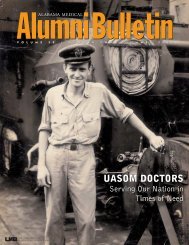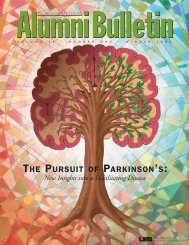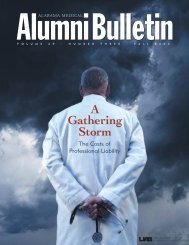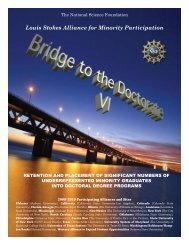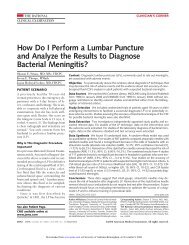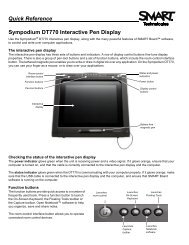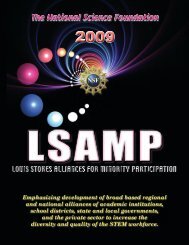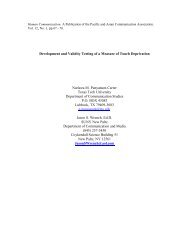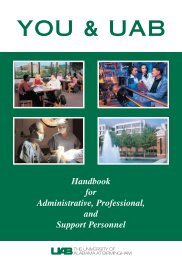In Pursuit of Precision - University of Alabama at Birmingham
In Pursuit of Precision - University of Alabama at Birmingham
In Pursuit of Precision - University of Alabama at Birmingham
You also want an ePaper? Increase the reach of your titles
YUMPU automatically turns print PDFs into web optimized ePapers that Google loves.
Cover Story<br />
chronic sinusitis, tumors, and spinal fluid leaks. Sillers began<br />
using computer-based surgery for chronic rhinosinusitis in 1996.<br />
Since then, computer-assisted techniques have expanded to<br />
other areas, including surgery for skull-based tumors.<br />
<strong>In</strong> an article written for the winter 2002 issue <strong>of</strong> UAB <strong>In</strong>sight,<br />
Sillers explains th<strong>at</strong> the complex an<strong>at</strong>omy <strong>of</strong> the anterior skull base<br />
makes tumors difficult to remove. A computerized surgical navig<strong>at</strong>ion<br />
system helps correl<strong>at</strong>e images seen endoscopically with preoper<strong>at</strong>ive<br />
CT scans. With improved technical precision, the surgeon can remove<br />
tumors more completely and tre<strong>at</strong> larger skull tumors.<br />
“Although this hasn’t been proven st<strong>at</strong>istically, I believe computer-assisted<br />
surgery has increased safety by reinforcing surgical<br />
landmarks and reduced overall complic<strong>at</strong>ions for p<strong>at</strong>ients. It’s<br />
also increased the surgeon’s ability to do a complete job <strong>of</strong> tumor<br />
removal, or removal <strong>of</strong> disease in chronic sinusitis or nasal<br />
polyps,” Sillers says. “More applic<strong>at</strong>ions in nasal, skull base, and<br />
ear surgery lie ahead.”<br />
PLASTIC SURGERY ON THE NONCUTTING EDGE<br />
Jorge de la Torre, M.D., gives credit to plastic surgery department<br />
director Luiz Vasconez, M.D., for initi<strong>at</strong>ing endoscopic<br />
approaches to plastic surgery <strong>at</strong> UAB.<br />
“Plastic surgery was one <strong>of</strong> the last specialties to take advantage<br />
<strong>of</strong> these techniques because <strong>of</strong> where in the body we work,”<br />
says de la Torre, assistant pr<strong>of</strong>essor <strong>of</strong> plastic surgery. “Surgeons<br />
working in the abdomen have a nice cavity where they can look<br />
in and see wh<strong>at</strong> they’re doing. We had to customize endoscopic<br />
needs for plastic surgery, developing some ancillary equipment<br />
to dil<strong>at</strong>e and suspend tissue so we can cre<strong>at</strong>e a cavity in which we<br />
can see and work.”<br />
De la Torre says he is now using endoscopes for a variety <strong>of</strong><br />
procedures, including forehead lifts and breast augment<strong>at</strong>ions.<br />
He also uses endoscopic techniques to harvest tissue in the<br />
abdomen for reconstructive surgery.<br />
“The use <strong>of</strong> the endoscope not only allows us to make smaller<br />
incisions, but it also enables us to magnify the structures we’re<br />
looking <strong>at</strong>. <strong>In</strong> many cases, we can visualize these structures better<br />
than we could with a large incision,” de la Torre says.<br />
“There’s more precise control, and less bruising and swelling<br />
afterward. With endoscopic surgery, we also avoid some undesirable<br />
side effects <strong>of</strong> large incisions, such as scar loc<strong>at</strong>ion and<br />
impact on hair growth.”<br />
De la Torre believes the trend will acceler<strong>at</strong>e. He and other surgeons<br />
using CAMI techniques are excited about the potential <strong>of</strong><br />
the new AIMS center for training residents and practicing surgeons,<br />
and for developing new equipment and techniques.<br />
As orthopedic surgeon Jorge Alonso says, “This approach to<br />
surgery is like surfing. You have to get in the wave early to stay on<br />
top. We got in the wave very early. And we can stay on top.”<br />
New <strong>In</strong>stitute Will Support Training, Research<br />
Although numerous UAB surgeons<br />
have used computer-assisted, minimally<br />
invasive techniques and equipment<br />
for several years, they’ve done<br />
so independently or within surgical<br />
departments. The newly established<br />
<strong>Alabama</strong> <strong>In</strong>stitute for Minimally<br />
<strong>In</strong>vasive Surgery (AIMS) will soon<br />
change th<strong>at</strong> situ<strong>at</strong>ion. AIMS has two<br />
major goals: to provide training<br />
opportunities spanning every specialty<br />
in surgery, and to support research<br />
and innov<strong>at</strong>ion in new areas <strong>of</strong> minimally<br />
invasive surgery.<br />
“This is a comprehensive effort,<br />
spurred on by the vision <strong>of</strong> Dr. Kirby<br />
Bland, chair <strong>of</strong> the Department <strong>of</strong><br />
Surgery,” says Ronald Clements,<br />
M.D., AIMS director. “Our first objective<br />
is to have a comprehensive training<br />
program for the surgical residents,<br />
so when they leave here, they can<br />
perform minimally invasive surgery<br />
safely and effectively. Another goal is<br />
to conduct continuing educ<strong>at</strong>ion programs<br />
for practicing surgeons who<br />
haven’t received training in current<br />
procedures.”<br />
<strong>In</strong> addition to clinical training,<br />
AIMS will have a conference facility<br />
and telecommunic<strong>at</strong>ions center in<br />
Volker Hall. “The telecommunic<strong>at</strong>ions<br />
center will connect <strong>University</strong><br />
Hospital, the Kirklin Clinic, Children’s<br />
Hospital, and sites anywhere else in<br />
the world,” Clements says. “For<br />
instance, if I’m conducting a teaching<br />
conference on laparoscopic gastric<br />
bypass surgery, surgeons in the<br />
conference room can see the live<br />
oper<strong>at</strong>ion, and we can talk back and<br />
forth as the surgery is performed.”<br />
Clements is one <strong>of</strong> three surgeons<br />
in the Department <strong>of</strong> Surgery<br />
who have received postresidency<br />
training in laparoscopic surgery.<br />
The others are Gregg Shore, M.D.,<br />
and Mary Hawn, M.D. Hawn, assistant<br />
pr<strong>of</strong>essor <strong>of</strong> surgery, is AIMS<br />
codirector for training.<br />
“The residents will have simul<strong>at</strong>ion<br />
training initially,” Hawn says.<br />
“They’ll practice suturing in a box<br />
where they’ll use a reflective mirror<br />
th<strong>at</strong> re-cre<strong>at</strong>es the two dimensional<br />
feeling you have when doing<br />
laparoscopy. You’re doing a threedimensional<br />
oper<strong>at</strong>ion with a twodimensional<br />
image, so you must<br />
work on other ways to determine<br />
depth perception and tissue<br />
strength. We’re also looking <strong>at</strong><br />
using a virtual reality trainer. But<br />
these are still in the early stages <strong>of</strong><br />
development, and it will mostly be a<br />
research tool to see if we can correl<strong>at</strong>e<br />
performance on the trainer<br />
with resident performance.”<br />
Clements has recruited AIMS<br />
represent<strong>at</strong>ives from every surgical<br />
specialty. One team member,<br />
Sharmila Makhija, M.D., assistant<br />
pr<strong>of</strong>essor <strong>of</strong> gynecologic oncology,<br />
says th<strong>at</strong> while laparoscopy has<br />
been a longtime practice in removal<br />
<strong>of</strong> ovaries, it’s still a new technique<br />
for surgical staging, which requires<br />
sampling lymph nodes. “Minimally<br />
invasive surgery is pretty new to our<br />
field, but we look forward to being<br />
part <strong>of</strong> the team,” she says.<br />
Clements and Hawn envision<br />
AIMS as a launching pad, both<br />
for basic research th<strong>at</strong> applies to<br />
clinical situ<strong>at</strong>ions, and for testing<br />
new techniques and equipment.<br />
“Manufacturers want surgeons to<br />
try out new s<strong>of</strong>tware and equipment,”<br />
Clements says. “We expect<br />
to be part <strong>of</strong> th<strong>at</strong> research effort.”<br />
The objective <strong>of</strong> AIMS will be to<br />
expand surgical skills—not alter them.<br />
“If our technology fails, you have to<br />
have a backup or convert to the traditional<br />
open oper<strong>at</strong>ion,” Clements<br />
says. “You have to have a safety net.”<br />
9



